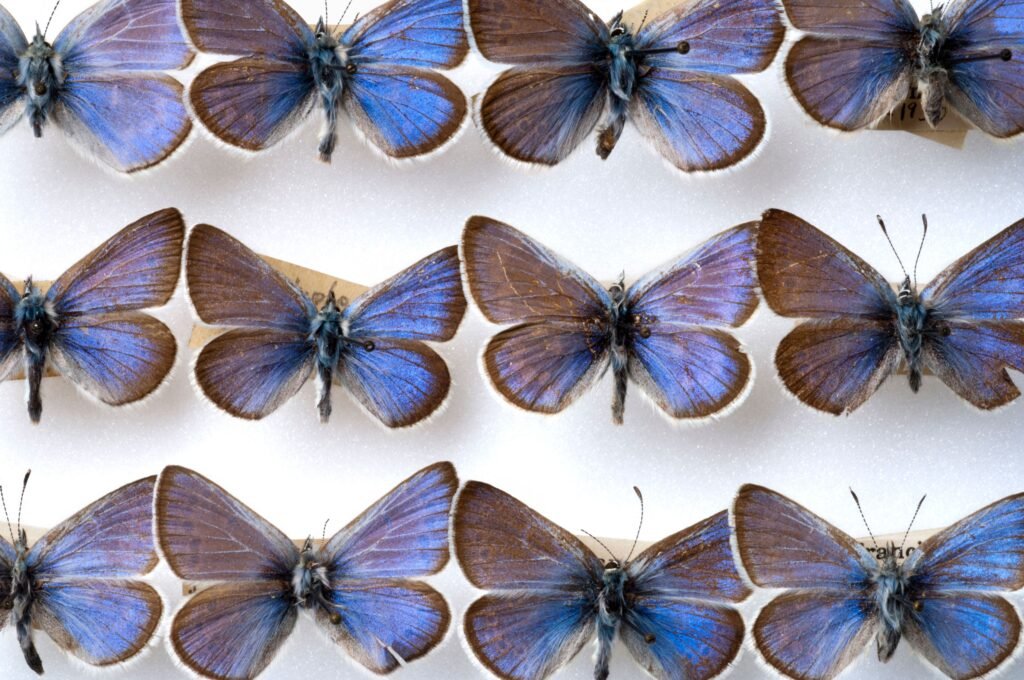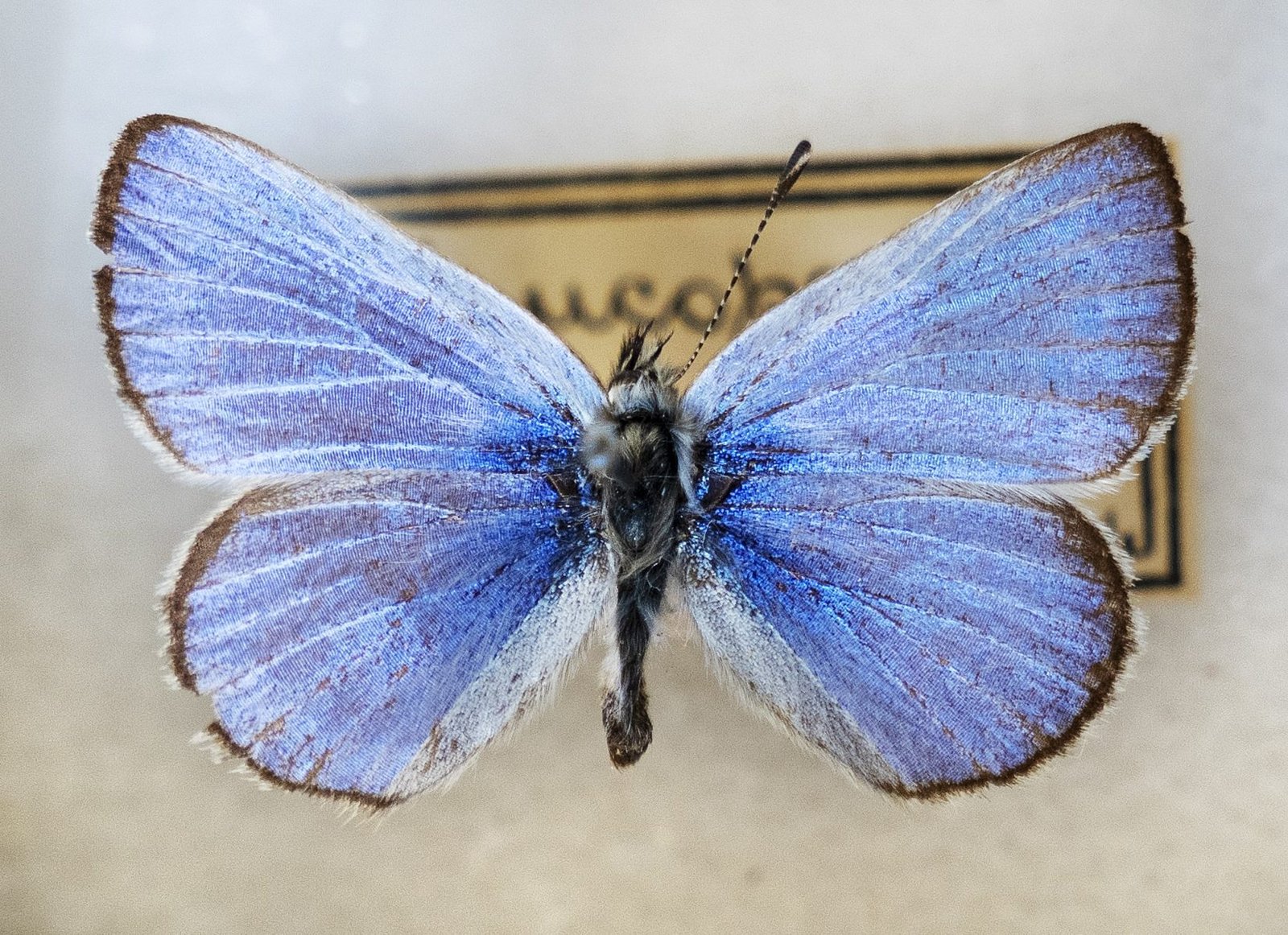Unveiling Xerces Blue: The Lost Jewel of California’s Dunes
The Xerces Blue, scientifically known as Glaucopsyche xerces, was a stunningly beautiful butterfly native to the coastal sand dunes of San Francisco, California. With its iridescent blue wings, this butterfly was a symbol of the delicate balance of coastal ecosystems. Unfortunately, urban development and habitat destruction led to its extinction in the early 1940s. The Xerces Blue holds the distinction of being the first North American butterfly to become extinct due to human activities, highlighting the urgent need for habitat preservation.
Facts:
| Attribute | Details |
|---|---|
| Scientific Name | Glaucopsyche xerces |
| Common Names | Xerces Blue |
| Year Declared Extinct | Early 1940s |
| Kingdom | Animalia |
| Phylum | Arthropoda |
| Class | Insecta |
| Order | Lepidoptera |
| Family | Lycaenidae |
| Genus | Glaucopsyche |
| Species | G. xerces |
| Natural History and Origin | Native to the coastal sand dunes of San Francisco, California |
| Physical Information | Small size, wingspan about 2.5-3.5 cm |
| Appearance | Iridescent blue wings with black margins in males, grayish wings with blue spots in females |
| Scientist Names | Described by early lepidopterists in the 19th century |
| Region | San Francisco, California |

Appearance:
The Xerces Blue was a small butterfly with a wingspan of approximately 2.5 to 3.5 centimeters. Male Xerces Blues had vibrant, iridescent blue wings with dark black margins, while females had grayish wings with blue spots. The underside of the wings was pale gray with black spots, providing effective camouflage against predators when the butterfly was at rest.
Distribution:
Historically, the Xerces Blue was found exclusively in the coastal sand dunes of San Francisco, California. This highly specialized habitat provided the necessary conditions for the butterfly’s life cycle, including the presence of specific host plants for its larvae.
Habits and Lifestyle:
The Xerces Blue was a diurnal butterfly, most active during the warm, sunny days of spring and summer. It thrived in the unique microhabitats of the coastal dunes, where it laid eggs on specific host plants, primarily members of the lupine family. The larvae fed on these plants until they pupated, emerging as adults to continue the life cycle. Xerces Blues were solitary insects, although they could often be seen congregating in areas with abundant flowers for nectar.
Physical Characteristics:
The Xerces Blue had several physical adaptations suited to its coastal environment. Its iridescent blue wings helped in thermoregulation, absorbing sunlight to maintain body temperature. The butterfly’s small size and agile flight made it well-suited to navigating the windswept dune habitats. The coloration provided camouflage among the flowers and sandy substrate, aiding in predator avoidance.
Diet and Nutrition:
As adults, Xerces Blues primarily fed on nectar from a variety of flowering plants. The nectar provided essential sugars and nutrients for energy and reproduction. The larvae were specialized feeders, consuming leaves of specific host plants in the lupine family. This close ecological relationship between the butterfly and its host plants made it highly sensitive to changes in its habitat.
Behavior:
Xerces Blues exhibited typical butterfly behaviors, including basking in the sun to regulate their body temperature, visiting flowers for nectar, and engaging in courtship displays. Males were often seen patrolling their territories, searching for receptive females. Females laid their eggs on the leaves of host plants, ensuring that the larvae had immediate access to food upon hatching.
Cause of Extinction:
The primary cause of the Xerces Blue’s extinction was habitat destruction due to urban development in San Francisco. The rapid expansion of the city in the early 20th century led to the loss of the coastal sand dunes that the butterfly depended on. Without its specialized habitat and host plants, the Xerces Blue population declined rapidly. By the early 1940s, the species was declared extinct, marking the first documented butterfly extinction in North America caused by human activities.
FAQs:
| Question | Answer |
|---|---|
| What led to the extinction of the Xerces Blue? | Habitat destruction due to urban development in San Francisco. |
| When did the Xerces Blue go extinct? | The early 1940s. |
| What did the Xerces Blue eat? | Adults fed on nectar from various flowers, while larvae fed on specific host plants in the lupine family. |
| Why is the Xerces Blue significant? | It is the first documented butterfly extinction in North America caused by human activities, highlighting the importance of habitat preservation. |
| Are there efforts to study the Xerces Blue? | Yes, ongoing research aims to understand its ecology and the impact of its extinction on the local environment. |

Categories:
- Extinct Insects
- North American Wildlife
- Conservation Efforts
- Coastal Ecosystems
These details should provide a comprehensive overview of the Xerces Blue, ideal for educational and conservation-focused content on your website.
Views: 16
